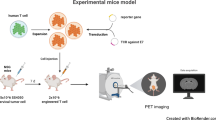Abstract Purpose:
The efficiency of adoptive cellular immunotherapy of cancer might depend on the number of effector cells that reach the malignant tissues. In the present study, the biodistribution and tumor localization of ex vivo lymphokine-activated T killer (T-LAK) cells was investigated. Methods: T-LAK cells were labeled with 125I-dU or the fluorescent dye tetramethylrhodamine isothiocyanate (TRITC) and transferred by intravenous, -cardiac, -portal or -peritoneal injection into normal (C57BL/6) mice or mice with syngeneic day-7 to day-12 B16 melanoma metastases established in various organs. The overall biodistribution of the T-LAK cells was measured by gamma counting and their tumor localization by fluorescence microscopy. Results: At 16 h after intravenous injection, the organ distribution of 125I-dU-labeled T-LAK cells was identical in normal and tumor-bearing animals. Fluorescence microscopy of lung tissue from animals receiving TRITC-labeled T-LAK cells revealed, however, a fivefold higher accumulation of T-LAK cells in lung metastases than in the surrounding normal lung tissue (1174 and 226 cells/mm2 respectively). Some pulmonary metastases were, however, resistant to infiltration. Very few intravenously injected cells redistributed to other organs or to tumors in these, since only 60 and 30 T-LAK cells/mm2 were found within metastases of the adrenal glands and the liver respectively. However, following injection of T-LAK cells via the left ventricle of the heart, a threefold increase (from 60 to 169 cells/mm2) in the number of transferred cells in metastases of the adrenal glands was observed. Moreover, following locoregional administration of T-LAK cells into the portal vein, tenfold higher numbers (from 30 to 400 cells/mm2) were found in hepatic metastases than were observed following intravenous or intracardiac injection. In the liver, a surprisingly large number of intraportally injected T-LAK cells (approx. 1300/mm2) were observed to accumulate in the perivascular spaces of the portal, but not the central veins. Even though some superficial ovarian and liver metastases were separated from the peritoneal cavity by only the peritoneal lining, no localization into these metastases was seen following intraperitoneal injection of the T-LAK cells. While treatment of tumor-bearing animals with T-LAK cells plus IL-2 reduced lung metastases by 76% as compared to treatment with IL-2 alone (P < 0.03), no significant reduction of liver metastases was seen. Conclusions: T-LAK cells are able to localize substantially into tumor metastases in various anatomical locations, but mainly following locoregional injection. This finding might have important implications for the design of future clinical protocols of adoptive immunotherapy based on T cells.
Similar content being viewed by others
Author information
Authors and Affiliations
Additional information
Received: 29 April 1999 / Accepted: 5 August 1999
Rights and permissions
About this article
Cite this article
Kjærgaard, J., Hokland, M., Agger, R. et al. Biodistribution and tumor localization of lymphokine-activated killer T cells following different routes of administration into tumor-bearing animals. Cancer Immunol Immunother 48, 550–560 (2000). https://doi.org/10.1007/PL00006673
Issue Date:
DOI: https://doi.org/10.1007/PL00006673




